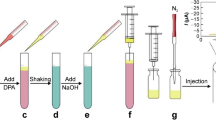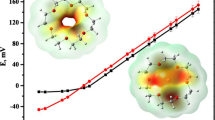Abstract
A glassy carbon electrode (GCE) was modified with a film containing titanium dioxide and a Pt(II)-porphyrin complex, and its response to quercetin was investigated employing cyclic voltammetry and chronoamperometry. The oxidation current caused by quercetin is largely enhanced under UV illumination. The effects of pH value, mass of TiO2 in the film, UV illumination time and applied potential were studied. Under optimized conditions, the peak current at a typically applied voltage of +0.4 V depends linearly on the concentration of quercetin in the 0.002 to 50 mg L−1 range. The detection limit (at an SNR of 3) is 0.8 μg L−1. The method was successfully applied to the determination of quercetin in (spiked) samples of tea and apple juice.

Figure Cyclic voltammograms of the TiO2/PtP/GCE in the absence and presence of various concentrations of quercetin in 0.1 M NaOH. a-e: 0, 0.1, 0.2, 0.3 and 0.4 mg L-1.






Similar content being viewed by others
References
Wach A, Pyrzynska K, Biesaga M (2007) Quercetin content in some food and herbal samples. Food Chem 100:699
Di Carlo G, Mascolo N, Izzo AA, Capasso F (1999) Flavonoids: old and new aspects of a class of natural therapeutic drugs. Life Sci 65:337
Kao TH, Huang SC, Inbaraj BS, Chen BH (2008) Determination of flavonoids and saponins in gynostemma pentaphyllum (thunb.) Makino by liquid chromatography -mass spectrometry. Anal Chim Acta 626:200
Scalbert A, Manach C, Morand C, Remesy C, Jimenez L (2005) Dietary polyphenols and the prevention of diseases. Crit Rev Food Sci Nutr 45:287
Ranjbari E, Biparva P, Hadjmohammadi MR (2012) Utilization of inverted dispersive liquid–liquid microextraction followed by HPLC-UV as a sensitive and efficient method for the extraction and determination of quercetin in honey and biological samples. Talanta 89:117
Schieber A, Kelle P, Carle R (2001) Determination of phenolic acids and flavonoids of apple and pear by high-performance liquid chromatography. J Chromatogr A 910:265
Cao YH, Zhang X, Fang YH, Ye JN (2001) Determination of active ingredients of apocynum venetum by capillary electrophoresis with electrochemical detection. Microchim Acta 137:57
Chen G, Zhang HW, Ye JN (2000) Determination of rutin and quercetin in plants by capillary electrophoresis with electrochemical detection. Anal Chim Acta 423:69
Lei R, Xu X, Yu F, Li N, Liu HW, Li K (2008) A method to determine quercetin by enhanced luminol electrogenerated chemiluminescence (ECL) and quercetin autoxidation. Talanta 75:1068
Wu HW, Chen ML, Fan YC, Elsebaei FW, Zhu Y (2012) Determinationofrutinand quercetin in Chinese herbal medicine by ionic liquid-based pressurized liquid extraction-liquid chromatography-chemiluminescence detection. Talanta 88:222
Qiu HM, Luo CN, Sun M, Lu FG, Fan LL, Li XJ (2012) A novel chemiluminescence sensor for determination of quercetin based on molecularly imprinted polymeric microspheres. Food Chem 134:469
Liu JM, Lin LP, Wang XX, Cai WL, Zhang LH, Lin SQ (2012) A highly sensitive couplingtechnique for the determination of trace quercetin based on solid substrate room temperature phosphorimetry and poly (vinyl alcohol) complex imprinting. Anal Chim Acta 723:76
Pejic N, Kuntic V, Vujic Z, Micic S (2004) Direct spectrophotometric determination of quercetin in the presence of ascorbic acid. Il Farmaco 59:21
Sun S, Zhang MQ, Li YJ, He XW (2013) A molecularly imprinted polymer with incorporated graphene oxide for electrochemical determination of quercetin. Sensors 13:5493
Yola ML, Atar N, Üstündag Z, Solak AO (2013) A novel voltammetric sensor based on p-aminothiophenol functionalized graphene oxide/gold nanoparticles for determining quercetin in the presence of ascorbic acid. J Electroanal Chem 698:9
Zielinska D, Nagels L, Piskula MK (2008) Determination of quercetin and its glucosides in onion by electrochemical methods. Anal Chim Acta 617:22
Liang Y, Cao W, Chen WJ, Xiao XH, Zheng JB (2009) Simultaneous determination of four phenolic components in citrus honey by high performance liquid chromatography using electrochemical detection. Food Chem 114:1537
Okada N, Karuppuchamy S, Kurihara M (2005) An efficient dye-sensitized photoelectrochemical solar cell made from CaCO3 coated TiO2 nanoporous film. Chem Lett 34:16
Espinoza LAT, Rembor M, Matesanz CA, Heidt A, Frimmel FH (2009) Formation of bromoform in irradiated titanium dioxide suspensions with varying photocatalyst, dissolved organic carbon and bromide concentrations. Water Res 43:4143
Jo WK, Kim JT (2009) Application of visible-light photocatalysis with nitrogen-doped or unmodified titanium dioxide for control of indoor-level volatile organic compounds. J Hazard Mater 164:360
Wang HE (2011) Facile synthesis and electrochemical of porous and dense TiO2 nanospheres for lithium-ion battery applications. J Power Sources 196:6394
Wang Y, Chen T, Mu QJ (2011) Electrochemical performance of W-doped anatase TiO2 nanoparticles as an electrode material for lithium-ion batteries. J Mater Chem 21:6006
Bao SJ, Li CM, Zang JF, Cui XQ, Qiao Y, Guo J (2008) New nanostructured TiO2 for direct electrochemistry and glucose sensor applications. Adv Funct Mater 18:591
Luo YP, Liu HQ, Rui Q, Tian Y (2009) Detection of extracellular H2O2 released from human liver cancer cells based on TiO2 nanoneedles with enhanced electron transfer of cytochrome c. Anal Chem 81:3035
Tang H, Yan F, Tai QD, Chan HLW (2010) The improvement of glucose bioelectrocatalytic properties of platinum electrodes modified with electrospun TiO2 nanofibers. Biosens Bioelectron 25:1646
Li Q, Cheng K, Weng WJ, Du PY, Han GR (2013) Titanium dioxide nanorod-based amperometric sensor for highly sensitive enzymatic detection of hydrogen peroxide. Microchim Acta 180:1487
Li Q, Cheng K, Weng WJ, Du PY, Han GR (2012) Highly sensitive hydrogen peroxide biosensors based on TiO2 nanodots/ITO electrodes. J Mater Chem 22:9019
Doong R, Shih H (2010) Array-based titanium dioxide biosensors for ratiometric determination of glucose, glutamate and urea. Biosens Bioelectron 25:1439
Kurzatkowska K, Shpakovsky D, Radecki J, Radecka H, Zhang JW, Milaeva E (2009) Iron (III) porphyrin bearing 2,6-di-tert-butylphenol pendants deposited onto gold electrodes for amperometric determination of l-histidine. Talanta 78:126
Wang BB, Zhang LM, Li B, Li Y, Shi YH, Shi TS (2014) Synthesis, characterization, and oxygen sensing properties of functionalized mesoporous silica SBA-15 and MCM-41 with a Pt(II)–porphyrin complex. Sensors Actuators B 190:93
Zhu QG, Sujari ANA, Ghani SA (2013) Nafion-MWCNT composite modified graphite paste for the analysis of quercetin in fruits of Acanthopanax sessiliflorus. Sensors Actuators B 177:103
Xu GR, Kim SH (2006) Selective determination of quercetin using carbon nanotube modified electrodes. Electroanalysis 18:1786
Jin GP, He JB, Rui ZB, Meng FS (2006) Electrochemical behavior and adsorptive stripping voltammetric determination of quercetin at multi-wall carbon nanotubes modified paraffin-impregnated graphite disk electrode. Electrochim Acta 51:4341
Chen XR, Li Q, Yu SJ, Lin B, Wu KB (2012) Activated silica gel based carbon paste electrodes exhibit signal enhancement for quercetin. Electrochim Acta 81:106
Acknowledgments
The authors acknowledge gratefully the financial support of the program of Science and Technology of Department of Education of Jilin Province (No. 2014263) and Changchun Normal University Natural Science Foundation.
Author information
Authors and Affiliations
Corresponding author
Electronic supplementary material
Below is the link to the electronic supplementary material.
ESM 1
(PDF 1060 kb)
Rights and permissions
About this article
Cite this article
Tian, L., Wang, B., Chen, R. et al. Determination of quercetin using a photo-electrochemical sensor modified with titanium dioxide and a platinum(II)-porphyrin complex. Microchim Acta 182, 687–693 (2015). https://doi.org/10.1007/s00604-014-1374-7
Received:
Accepted:
Published:
Issue Date:
DOI: https://doi.org/10.1007/s00604-014-1374-7




